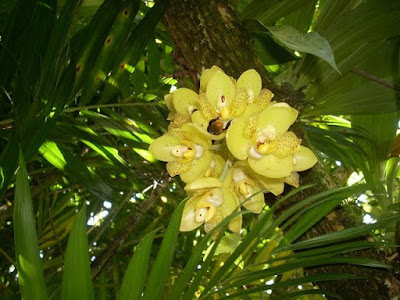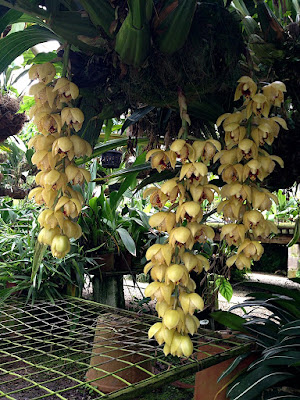Acineta chrysantha is found in the forest of Guatemala, El Salvador, Costa Rica and Panama. They grow in moist cloud forests at elevations around 1300 meters above sea level.
Acineta chrysantha also called as The Golden-Yellow Flowered Acineta, Acineta densa, Acineta warscewiczii, Neippergia chrysantha, is a species of the genus Acineta. This species was described by John Lindley in 1850.
IDENTIFY ACINETA CHRYSANTHA ORCHID PLANT
Acineta chrysantha is found in the forest of Guatemala, El Salvador, Costa Rica and Panama. They grow in moist cloud forests at elevations around 1300 meters above sea level.
It is a large sized, warm to cool growing epiphyte with clustered, ovoid to cylindrical, glossy olive green, laterally compressed, finely sulcate pseudobulbs with a basal sheath and carrying 2 to 4, terminal, thick, glabrous, plicate, oblanceolate, acute, stalked leaves.
The Golden-Yellow Flowered Acineta blooms in the spring and early summer on a pendant, racemose, 70 cm long, 20 to 30 flowered inflorescence with papery bracts and very fleshy, cup-like, vanilla scented, long-lived flowers. The flowers are waxy and up to 6 cm wide and have a base color of deep or golden yellow with reddish spots on the petals and sepals. The labellum has large deep red spots and splotches. The column, in contrast, is ivory white and minutely hairy at the base. The fragrance of these orchids is rather complex, but ranges more toward a ginger or ginger beer fragrance. The flowers last much longer than most Stanhopea, from two weeks, sometimes up to three weeks if the weather is cool.
ACINETA CHRYSANTHA ORCHID PLANT CARE AND CULTURE
Cultural information should only be used as a guide, and should be to be adapted to suit you. Your physical location; where you grow your plants, how much time you have to devote to their care, and many other factors, will need to be taken into account. Only then can you decide on the cultural methods that best suit you and your plants.
Light:
Acineta chrysantha requires the light level of 17000-30000 lux with 50-60% shade clothes, but not direct sunlight. Direct light will burn the leaves.
Temperature:
The Golden-Yellow Flowered Acineta need a minimum winter nighttime temperature of 10 to 13°C, with daytime temperatures of 13 to 20°C. Diurnal temperature changes between 8-11°C should provide the proper conditions to initiate flowering.
Humidity:
During active growth, the plant requires 40% to 60% humidity. Too dry air has a negative effect on the development of the plant: its growth is inhibited, and the leaves begin to turn yellow and dry out. The higher temperature, the higher the humidity should be, and the higher the humidity, the more often and longer it is necessary to ventilate the room where the plants are contained, otherwise the probability of rotting and various kinds of fungal diseases.
Substrate, growing media and repotting:
Acineta chrysantha grow best in a wire basket with a lose weave that allows the pendent flower to penetrate through. They can also be mounted onto a tree fern or cork base. Paperbark tree bark or coconut fiber can be used but must not be too thick. Medium grade bark and perlite mix permitting very good drainage should be used possibly with some sphagnum moss mixed through to retain moisture.
Repotting about every 3 years is usually adequate. Repotting can delay flowering for 12 months. Repotting is best done in summer right after flowering is finished.
Watering:
The Golden-Yellow Flowered Acineta should be watered 3-4 times a week in hot weather and may require daily misting in very hot weather as they like high humidity. Avoid wetting the leaves in cool weather in winter as this can cause bacterial spotting on the leaves. They need dry winters and should receive little water and more sunlight in this period. These plants should only receive regular watering in mid spring when growth restarts.
Watering is directly dependent on the temperature of the content, the higher it is, the more often it needs to be watered. When watering, excess water should flow freely from the pot, since stagnation of water both inside the pot and in its pan can very quickly lead to rotting of the roots and the lower part of the plant.
Fertilizer:
You can fertilize with a diluted concentration once every months. Use a 30-10-10 high-nitrogen formulation, alternating with a 20-20-20 balanced formulation; in the blooming season, which is mainly summer, use a 10-30-20 blossom-booster formulation.
Rest period:
Acineta chrysantha requires a cool and semi-dry rest period in early winter to induce blooms. They need less water in the winter, especially if they grow under the conditions of a dark, short day that occurs at moderate latitudes. They should dry somewhat between waterings, but they should not be dry for a longer period. Frequent morning fogging and rare, economical watering should allow the plant to go through a dry period of rest, while providing it with sufficient humidity. Fertilization should be reduced or eliminated until new growths appear and a more abundant spring watering begins.















COMMENTS